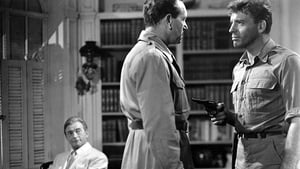Contact: [email protected]
Video Sources 0 Views

Synopsis
[ez-toc]





Embracing the Past and Future: Rope of Sand Colorized 1949
Introduction
In the realm of classic cinema, the timeless allure of old movies often lies in their black and white elegance. However, the art of colorization has been a subject of both fascination and controversy, with enthusiasts and purists locked in an ongoing debate about its ethical implications. One such classic film that has undergone a stunning transformation is “Rope of Sand Colorized,” a 1949 adventure-suspense film noir. The colorization of this cinematic gem not only brings new life to its visuals but also sparks discussions about the preservation and revitalization of old movies through modern technology.
Read Media File Transfer Agreement: Terms and Conditions
Read FAQ
The Art of Colorization in Film Restoration
Colorization stands as a pivotal technique in the realm of film restoration, aiming to breathe new life into monochrome masterpieces. Advancements in artificial intelligence technology have ushered in a new era for this process, allowing for more nuanced and authentic colorization. The meticulous application of color serves not only to enhance the aesthetic appeal but also to preserve the artistic essence of these cinematic treasures.
Understanding Rope of Sand Colorized (1949) and Its Significance
“Rope of Sand, Colorized” directed by William Dieterle, emerges as a notable entry in the adventure-suspense genre during 1949. The film boasts an intriguing narrative set against the backdrop of the African desert, with elements of noir adding to its mystique. The decision to colorize such a classic film is a bold move, challenging conventional perceptions and inviting audiences to experience the narrative in an entirely new light.
The Controversy Surrounding Colorization: Debates and Perspectives
The controversy surrounding colorization is as old as the technique itself. Traditionalists argue that it infringes upon the original artistic vision of directors who consciously chose the black and white aesthetic. On the flip side, proponents assert that colorization is a gateway to introducing classic cinema to younger audiences who might find black and white films less accessible. The debates and perspectives surrounding this issue continue to shape the landscape of film preservation.
The Restoration Process: Bringing New Life to Rope of Sand Colorized
Colorizing a film like “Rope of Sand Colorized” requires a delicate touch and a deep understanding of the source material. The restoration process involves meticulous attention to detail, ensuring that each frame is imbued with the right hues to complement the mood and setting. Technological advancements, particularly in AI, have played a pivotal role in streamlining and enhancing this restoration journey, making it more accurate and respectful of the original vision.
Analyzing the Plot and Visuals of Colorized Rope of Sand Colorized
As we delve into the plot of “Rope of Sand, Colorized” the colorization process reveals a new layer of depth to the film. The adventure-suspense narrative, set against the vast and unforgiving African desert, takes on a different dimension with the introduction of color. The nuances of the characters’ emotions and the intensity of the desert sequences are heightened, offering audiences a fresh perspective on a story that has stood the test of time.
The Cast that Brought Rope of Sand Colorized to Life
A crucial element of “Rope of Sand Colorized” is the stellar cast that breathed life into the characters. Burt Lancaster, Paul Henreid, Claude Rains, and Peter Lorre deliver performances that transcend the constraints of time. The colorization process accentuates the subtleties in their expressions, allowing modern audiences to connect with the characters on a more visceral level. The chemistry and charisma of the cast remain undiminished, even as the film undergoes a visual metamorphosis.
Filming Locations: From Yuma Desert to the Silver Screen
The choice of filming locations is a crucial aspect of any cinematic endeavor, and “Rope of Sand Colorized” is no exception. The Yuma Desert and the Sonoran Desert in California serve as dramatic backdrops that contribute to the film’s authentic atmosphere. The colorization process not only preserves the natural beauty of these locations but also amplifies their impact on the overall cinematic experience. The desolate landscapes, now vividly portrayed in color, become characters in their own right.
Reception and Legacy: Then vs Now for Colorized Rope of Sand
Upon its original release, “Rope of Sand” garnered critical acclaim for its suspenseful narrative and compelling performances. However, the colorized version has sparked debates about the inclusion of plot holes and alterations in the visual narrative. Contemporary reviews vary, with some praising the vibrant transformation and others critiquing the departure from the original black and white aesthetic. The film’s legacy, both in its colorized and original forms, continues to evolve as audiences reevaluate its impact on the cinematic landscape.
Preservation Through Innovation: The Role of Colorization in Safeguarding Classic Cinema
The colorization of “Rope of Sand Colorized” serves as a testament to the evolving landscape of film preservation. While purists may resist the idea of altering the visual integrity of classic films, the technological innovations in colorization provide a gateway to introducing these cinematic treasures to a new generation. By striking a balance between preservation and innovation, colorization becomes a tool for safeguarding classic cinema, ensuring that the artistry of bygone eras remains accessible and relevant.
Embracing the Past and Future: Rope of Sand as a Colorized Masterpiece
In conclusion, the colorization of “Rope of Sand” represents a bold and innovative approach to preserving classic cinema. The meticulous restoration process, coupled with advancements in AI technology, has breathed new life into this adventure-suspense film noir. The debate surrounding colorization will undoubtedly persist, but the transformation of “Rope of Sand” stands as a testament to the potential of this technique in bridging the gap between past and present.
As we embrace the past and look towards the future, films like “Rope of Sand” serve as cultural touchstones, inviting audiences to rediscover and appreciate the artistry of old movies in a new light. The delicate balance between preserving the original artistic vision and introducing innovative elements through colorization is a challenge that the film industry must navigate. “Rope of Sand Colorized 1949” exemplifies the potential of AI technology in the realm of film restoration, offering a vibrant testament to the enduring power of classic cinema.

















